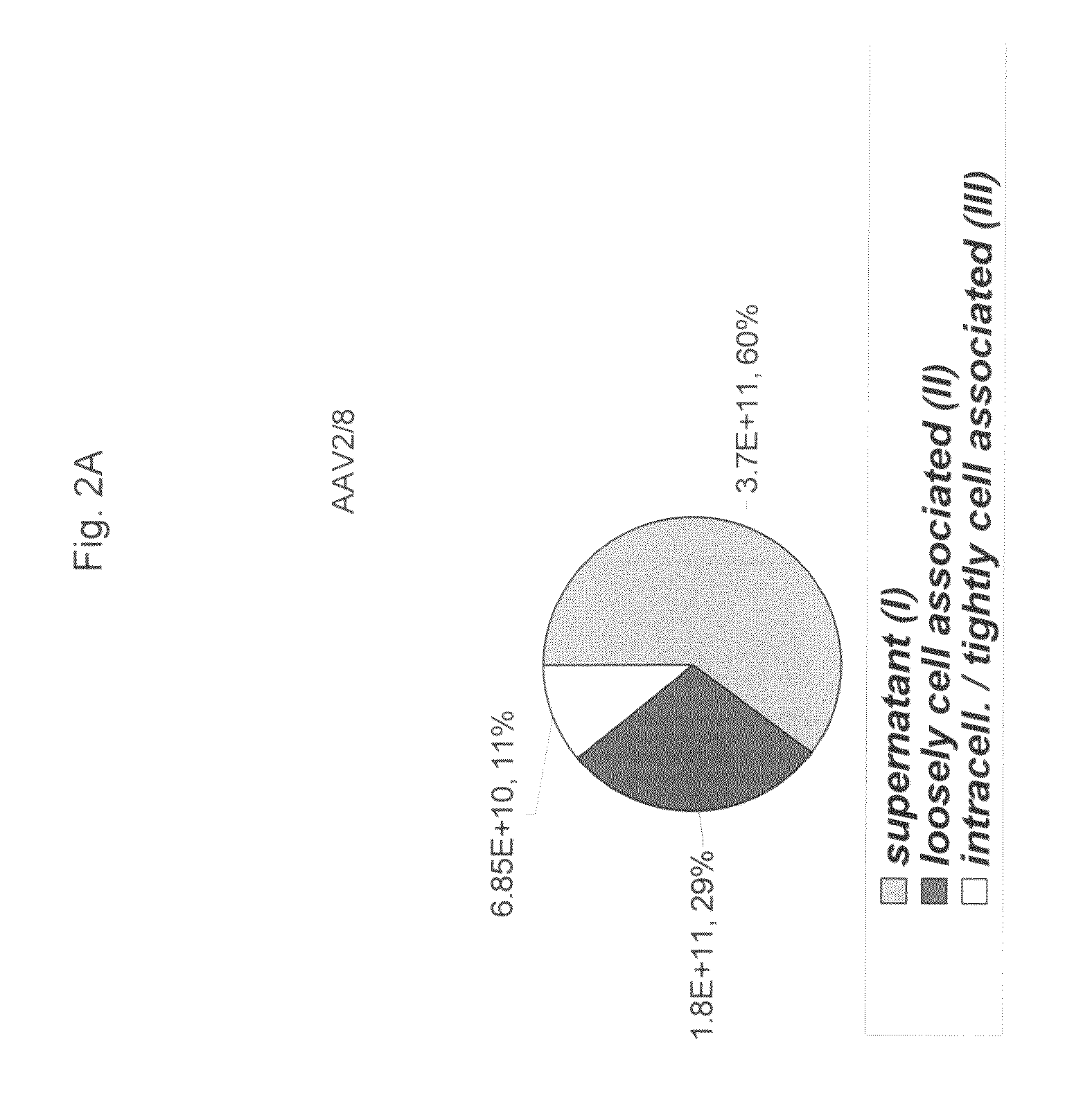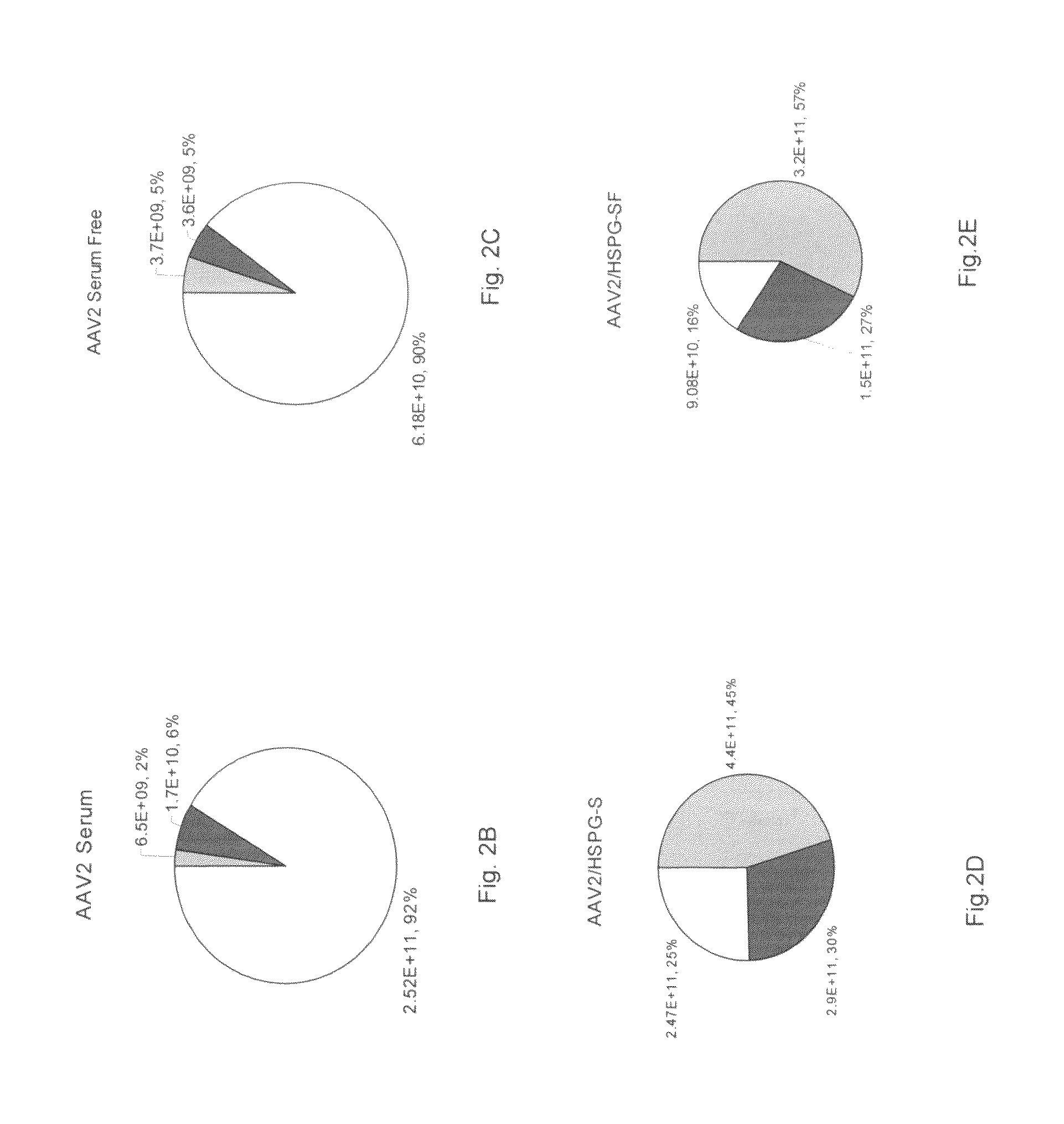Scalable production method for AAV
a production method and production method technology, applied in the field of new harvesting and production methods, can solve the problems of releasing intracellular proteins and debris into the viral harvest, reducing the efficiency of both production and purification, and increasing the difficulty of subsequent purification, so as to achieve high yield, reduce or eliminate binding, and improve the effect of purification
- Summary
- Abstract
- Description
- Claims
- Application Information
AI Technical Summary
Benefits of technology
Problems solved by technology
Method used
Image
Examples
example 1
[0071]Experimentals:
[0072]293 cells were transfected with CaPO4 with plasmids required for production of AAV, i.e., AAV2 rep, a adenoviral helper construct and a ITR flanked transgene cassette. The AAV2 rep plasmid also contains the cap sequence of the particular virus being studied. The cap sequence is the only variable in all experiments. These experiments have been repeated for several transgene cassettes. Twenty-four hours after transfection, which occurred in serum containing DMEM, the medium was replaced with fresh medium with or without serum. Three (3) days after transfection, a sample (I) was taken from the culture medium of the 293 adherent cells. Subsequently cells were scraped and transferred into a receptacle. After centrifugation to remove cellular pellet, a sample (II) was taken from the supernatant after scraping. Next cell lysis was achieved by three consecutive freeze-thaw cycles (−80° C. to 37° C.). Cellular debris was removed and sample (III) was taken from the m...
example 2
[0081]Vector release into the supernatant was investigated for serotypes 1, 2, 3, 5, 6, 7, 8 and 9 as well as novel vectors rh32.33, rh.10, hu.11, AAV6.2, AAV6.1, AAV6.1.2, rh64R1 and rh8R. AAV2, AAV2 / 3 and AAV2 / 5 were found to secrete minimal (less than 10% of total Dnase-resistant vector genomes or particles (drp vg)). AAV2 / 9 is released moderately into the supernatant during viral vector production (more than 10%, less than 20% of total drp vg). All other vectors tested secrete more than 20% of their viral particles into the supernatant during production onto 293 cells following triple transfection.
[0082]The infectivity of vectors harvested from the supernatant was compared to that of purified (CsCl pure with the exception of AAV2 which was heparin purified) preparations as well as vector harvested from cellular pellet lysates. AAV harvested from the supernatant was found to be of equal or higher infectivity when compared to the two latter fractions in a 293 transduction assay fo...
example 3
[0084]An immunization study was performed to assess the effect of a variety of AAV vectors having differing capsids on T-cell activation. The study compared a native AAV6 capsid, known to have a heparin binding domain at the lysine residue at position 531 to three modified AAV having capsids with site-specific modifications introduced. These AAV, designated AAV2 / 6.2 (modified at a position other than K531), AAV2 / 6.1 (having an AAV6 capsid [SEQ ID NO: 3] modified at position 531 to contain a glutamic acid (i.e., a non-conservative amino acid change), and AAV2 / 6.1.2, having an AAV6 capsid with both the modifications of the AAV6.2 and AAV6.1 capsid were utilized. The sequences and generation of these vectors is described in International Patent Appln No. PCT / US06 / 13375. AAV1 served as a negative control and AAV2 served as a positive control.
[0085]Balb / c mice (male) were immunized intramuscularly with 1×1011 GC AAV2 / 6, AAV2 / 6.1, AAV2 / 6.2, AAV2 / 6.1.2, AAV2 / 1 or AAV2 vector. Thirteen (13)...
PUM
| Property | Measurement | Unit |
|---|---|---|
| temperature | aaaaa | aaaaa |
| pH | aaaaa | aaaaa |
| serologic cross-reactivity | aaaaa | aaaaa |
Abstract
Description
Claims
Application Information
 Login to View More
Login to View More - R&D
- Intellectual Property
- Life Sciences
- Materials
- Tech Scout
- Unparalleled Data Quality
- Higher Quality Content
- 60% Fewer Hallucinations
Browse by: Latest US Patents, China's latest patents, Technical Efficacy Thesaurus, Application Domain, Technology Topic, Popular Technical Reports.
© 2025 PatSnap. All rights reserved.Legal|Privacy policy|Modern Slavery Act Transparency Statement|Sitemap|About US| Contact US: help@patsnap.com



